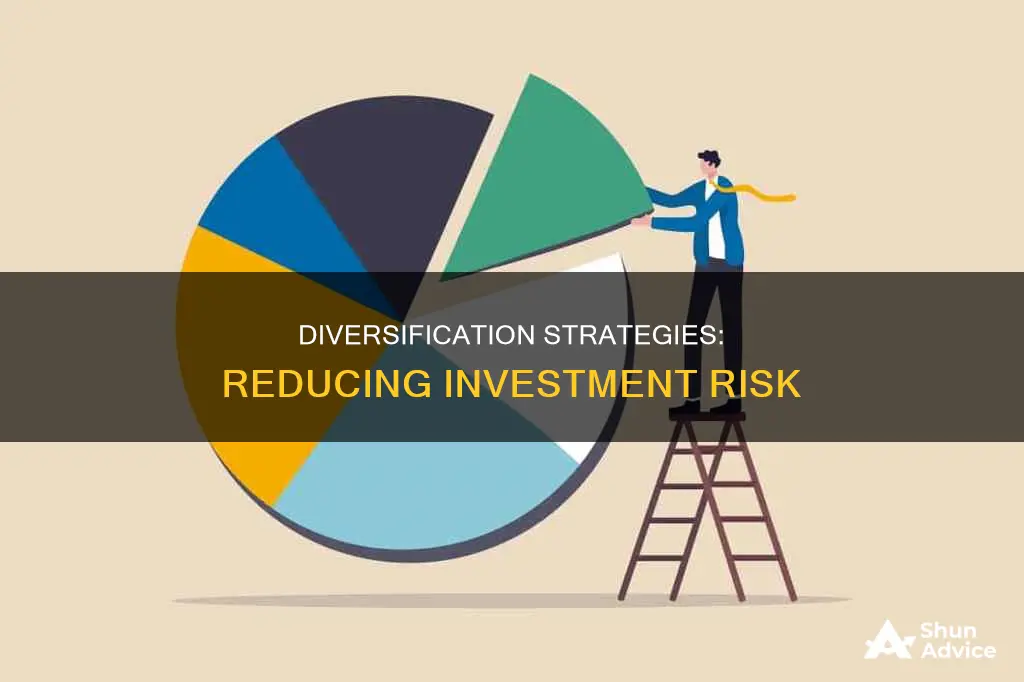
Diversification is a key strategy for investors to reduce the risk of their investments. It involves spreading investments across different asset classes, industries, and geographic regions to reduce the overall risk of an investment portfolio. By investing in a variety of assets, investors can offset potential losses in one area with gains in another, leading to more consistent returns. While diversification does not eliminate all risk, it can help investors manage and minimise losses, especially during market downturns. It is a long-term strategy that allows investors to balance risk and return, helping them achieve their financial goals while minimising potential losses.
| Characteristics | Values |
|---|---|
| Definition | Diversification is the process of spreading investments across different asset classes, industries, and geographic regions to reduce the overall risk of an investment portfolio. |
| Benefits | Protects against losses, increases risk-adjusted returns, creates better opportunities, makes investing more fun and enjoyable, and preserves capital. |
| Downsides | Can be cumbersome to manage, expensive, complicated, and may lead to lower portfolio-wide returns. |
| Types of Risk Addressed | Unsystematic or diversifiable risk, including business risk and financial risk. |
| Types of Risk Not Addressed | Systematic or market risk, including inflation rates, exchange rates, political instability, war, and interest rates. |
| Strategies | Diversify across sectors and industries, companies, asset classes, borders, and time frames. |
| Considerations | The right asset allocation depends on individual risk tolerance, time horizon, and financial goals. |
| Tools | Mutual funds and ETFs (exchange-traded funds) are common ways to achieve diversification. |
| Maintenance | Regular portfolio rebalancing is crucial to maintaining diversification over time. |
What You'll Learn

Diversification across sectors and industries
Diversification is a crucial strategy for managing investment risk and building long-term wealth. It is the process of spreading investments across different asset classes, industries, and geographic regions to reduce the overall risk of an investment portfolio. By holding a variety of investments, investors can offset the poor performance of one investment with the better performance of another, leading to a more consistent overall return.
When diversifying across sectors and industries, it is important to consider the following:
- Different sectors: It is recommended to spread your investments across various industries such as technology, healthcare, energy, financials, and transportation. This helps to mitigate the risk of poor performance in any one sector dragging down the entire portfolio. For example, an investor with a concentration of technology stocks should diversify their exposure by investing in other sectors.
- Geographic regions: Investing in both domestic and international markets, including developed and emerging economies, is an important aspect of diversification. This strategy can help to mitigate the risk of economic or political instability in a specific region. It also provides exposure to different growth paths and potential new opportunities for growth overseas.
- Company size: Diversifying across company sizes, such as small-cap, mid-cap, and large-cap companies, is another way to reduce risk. Larger companies tend to be more stable, while smaller companies may offer higher growth potential but with greater volatility.
- Risk profiles: A well-diversified portfolio includes a mix of lower-risk and higher-risk assets. For example, bonds are typically lower-risk and provide stability, while stocks are higher-risk and offer higher expected returns over the long term.
- Time horizon: The amount of time your money can remain invested will impact your diversification strategy. Holding investments for a longer time horizon allows for a greater opportunity to overcome temporary setbacks and achieve long-term growth.
- Regular rebalancing: It is important to periodically rebalance your portfolio by shifting earnings into parts of the portfolio that have not performed as well. This helps to maintain your intended asset allocation and ensures your portfolio aligns with your risk tolerance and goals.
By diversifying across sectors and industries, investors can reduce the impact of sector-specific downturns and manage the overall risk of their portfolio.
Open Architecture Investment Management: Unlocking Investment Opportunities
You may want to see also

Diversification across companies
Diversification is a crucial strategy for managing investment risk and building long-term wealth. It involves spreading investments across different asset classes, sectors, company sizes, and geographic regions. Here are some key considerations for diversification across companies:
- Different company sizes: Diversification increases by owning stocks from small, medium, and large companies. This ensures that your portfolio captures a range of businesses at various stages of growth and development.
- Different sectors: It is important to diversify across multiple sectors. For example, investing only in technology startups could lead to significant losses during a technology sector downturn. By diversifying into other sectors, such as healthcare, finance, or energy, you reduce the impact of sector-specific downturns.
- Geographic diversification: Investing in companies located in different countries or regions can help mitigate the risk associated with economic or political instability in a specific area. It provides exposure to different markets and reduces dependence on a single market's performance.
- Risk management: Diversification across companies helps manage idiosyncratic risk, or the risk associated with individual companies. By investing in a broad array of companies, you can reduce the impact of any single company's problems, such as poor management decisions or unexpected competition.
- Active management: Regularly review and rebalance your portfolio to maintain your desired level of diversification. Market movements can cause your asset allocation to drift, and periodic rebalancing ensures your portfolio remains aligned with your risk tolerance and investment goals.
- Correlation consideration: When diversifying across companies, consider selecting companies with low correlation. Choose companies from different sectors or industries that don't move in lockstep with each other. This helps protect your portfolio from extreme declines in a specific sector or industry.
Saving or Investing: Where Should Your Money Go?
You may want to see also

Diversification across asset classes
Diversification is a common investment strategy that involves spreading investments across different asset classes to reduce the risk of market volatility. The three main asset classes are stocks, bonds, and cash or cash equivalents. However, investors can also consider alternative investments such as real estate, precious metals, and cryptocurrencies.
Stocks, or equities, offer investors partial ownership of a company and tend to provide the highest long-term gains. However, they are also volatile, especially during economic downturns. Bonds, or fixed-income securities, are loans made to a company or government that pay interest to investors. They are considered more stable than stocks but usually offer lower returns. Cash or cash equivalents, such as the money in a savings account, have low risk and low returns.
To further diversify, investors can consider factors such as industry, company size, creditworthiness, and geography. For example, an investor can diversify their stock portfolio by investing in companies of different sizes (small, medium, and large companies) and from different sectors (technology, consumer, healthcare, etc.). Similarly, when investing in bonds, one can choose bonds with different terms and credit ratings from various issuers, such as the government, state and local governments, or corporations.
By diversifying across asset classes and within asset classes, investors can reduce the risk of major losses and manage market volatility. This strategy also increases the potential for overall return, as some assets will perform well while others do poorly, and this can change over time. Diversification is a key component of long-term financial planning and helps investors strike a balance between risk and return.
Pitching Strategies: Guide to Convince Portfolio Managers
You may want to see also

Diversification across borders
Diversification is a strategy that involves spreading investments across different asset classes, industries, and geographic regions to reduce the overall risk of an investment portfolio. By including international investments in this mix, investors can further reduce their risk and access a broader range of opportunities.
Economic conditions and market trends vary across regions, and investing across borders can help mitigate the impact of local market fluctuations. For instance, while the US makes up less than 50% of the overall global market capitalization, US investors often allocate the majority of their equity assets domestically. This home bias can cause investors to miss out on a wider range of investment opportunities and the potential for strong returns.
- Invest in international stocks: This can be done by purchasing American or Global Depositary Receipts (ADRs or GDRs), which are issued by US banks or depositary banks to foreign companies. These represent shares of a foreign company trading on a US or global stock exchange, denominated in US dollars or other currencies.
- Invest in multinational corporations: Multinational corporations are businesses with a significant presence in at least two countries, often with a globalized production process. This means your investment is indirectly exposed to the economic conditions and performance of multiple countries.
- Use international market ETFs and mutual funds: These offer diversification and professional management services, relieving investors from selecting and monitoring individual investments. They can hold a range of international assets, including stocks, bonds, currencies, crypto, real estate, and commodities.
- Include foreign investments in your portfolio: International stocks make up approximately 40% of the world equity market's value, and diversifying into global stocks can provide returns that are differentiated from those of domestic markets.
- Use closed-end funds: These are professionally managed funds that offer a compelling means to efficient international exposure. Unlike traditional, open-end funds, closed-end funds issue a set amount of shares upon inception, which trade on the secondary market. This means investors can purchase shares at a discount or premium, depending on supply and demand, performance, and yield.
By diversifying across borders, investors can access new opportunities, such as emerging markets, innovative technologies, or more developed industries in other countries. It also allows investors to benefit from the growth and development of the global economy and can potentially lead to greater returns with lower overall portfolio volatility. However, investing in foreign markets also exposes investors to additional risks, such as currency fluctuations, transaction costs, and political and economic instability.
Understanding Investment Management Costs: A Guide to Typical Fees
You may want to see also

Diversification across time frames
Diversification is a crucial investment strategy, and one of the primary types of diversification is time diversification. This strategy involves spreading your investments across different time periods to mitigate timing risk and enhance potential returns. By investing at regular intervals over an extended period, you can average out the cost of your investments, reducing the impact of short-term price fluctuations. This approach is known as Dollar-Cost Averaging (DCA) and it encourages a regular and consistent investment habit.
Time diversification is especially useful for individual investors who lack the time or expertise to closely track the market or those who are more risk-averse. It is often incorporated into a passive investing approach, where investments are automated and paired with a diverse portfolio of Exchange-Traded Funds (ETFs), mutual funds, bonds, and stocks.
When considering investments across time frames, it is important to understand the inherent risks and returns associated with different time horizons. For example, a long-term bond typically carries a higher rate of return due to its higher risk, while a short-term investment is more liquid and yields lower returns. An airline manufacturer may have a longer operating cycle compared to a retailer, and real estate holdings may be locked into long-term lease agreements.
The time horizon of your investments also impacts your diversification strategy. Generally, the longer you can remain invested, the more opportunity you have to overcome temporary setbacks. This is because, over a longer time frame, the negative impacts of market downturns can be balanced out by periods of growth.
In summary, time diversification is a powerful tool for managing investment risk and enhancing returns. It involves spreading your investments across different time periods, averaging out costs, and reducing the impact of short-term fluctuations. This strategy is particularly useful for investors who don't have the time or expertise to closely follow the market or those seeking a more passive approach. By pairing time diversification with a diverse portfolio of assets, investors can effectively manage risk and optimise their portfolio's potential growth.
Mortgage Payoff or Investing: Where Should Your Money Go?
You may want to see also
Frequently asked questions
Diversification is the process of spreading investments across different asset classes, industries, and geographic regions to reduce the overall risk of an investment portfolio.
Diversification reduces the risk of major losses that can result from overemphasizing a single security or asset class. This is especially true if the assets are "uncorrelated", meaning they react to economic events independently of one another. For example, stocks and bonds often move in different directions, so holding both of these asset classes can help manage risk.
Diversification helps protect against losses, which is especially important for older investors who need to preserve wealth and retirees or individuals approaching retirement who may no longer have a stable income. It is also thought to increase the risk-adjusted returns of a portfolio, and can create better opportunities for investing.







